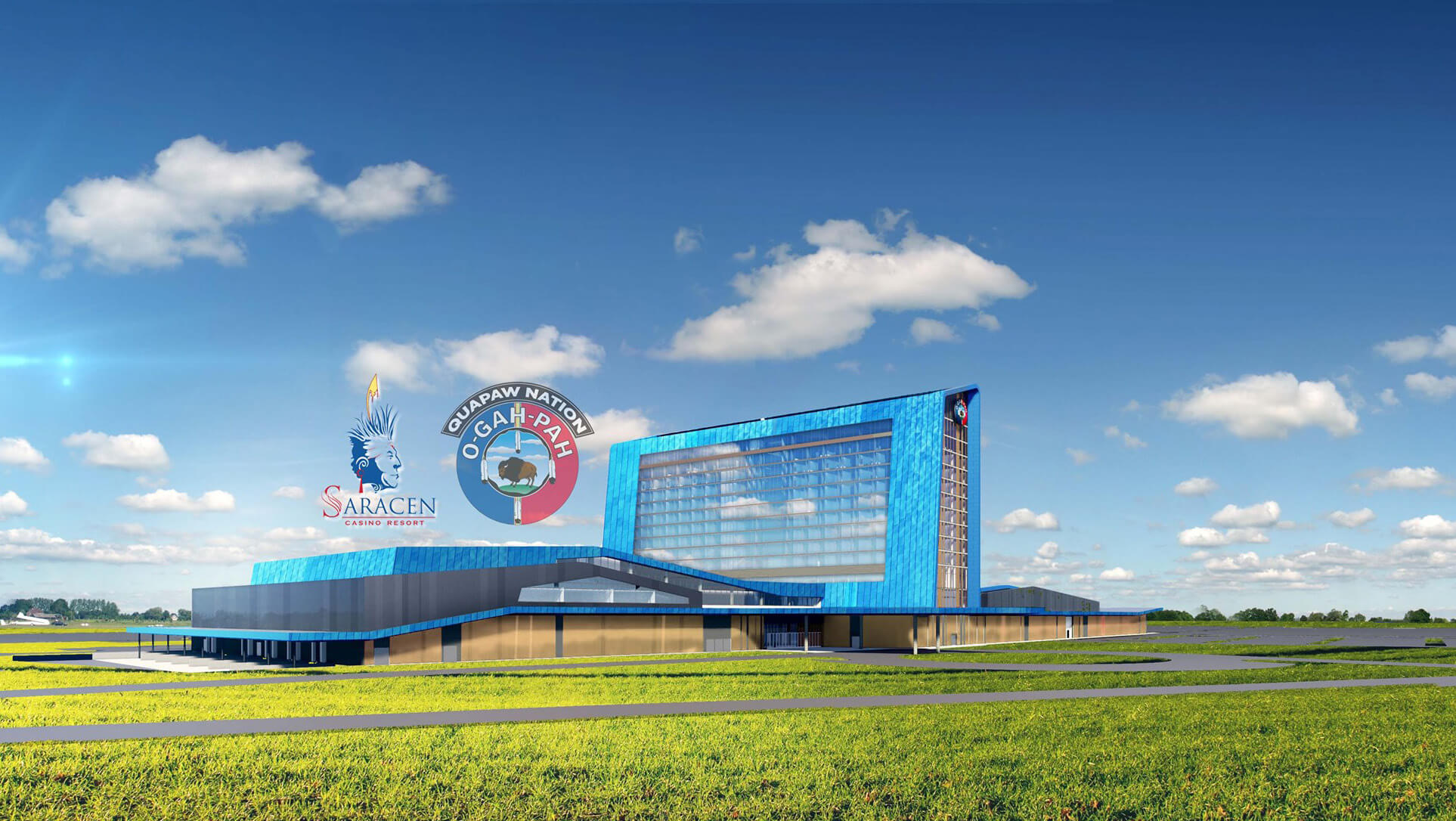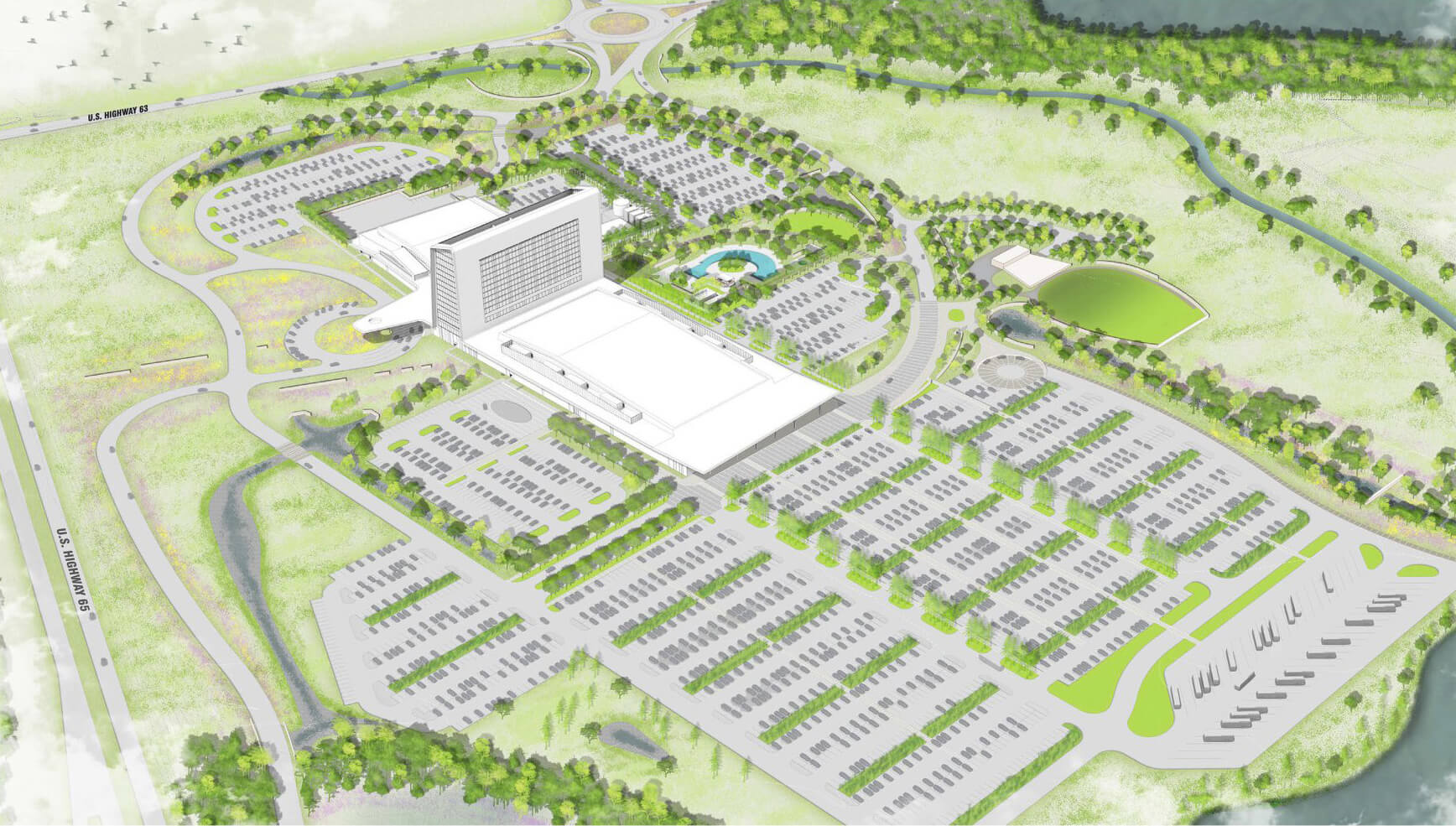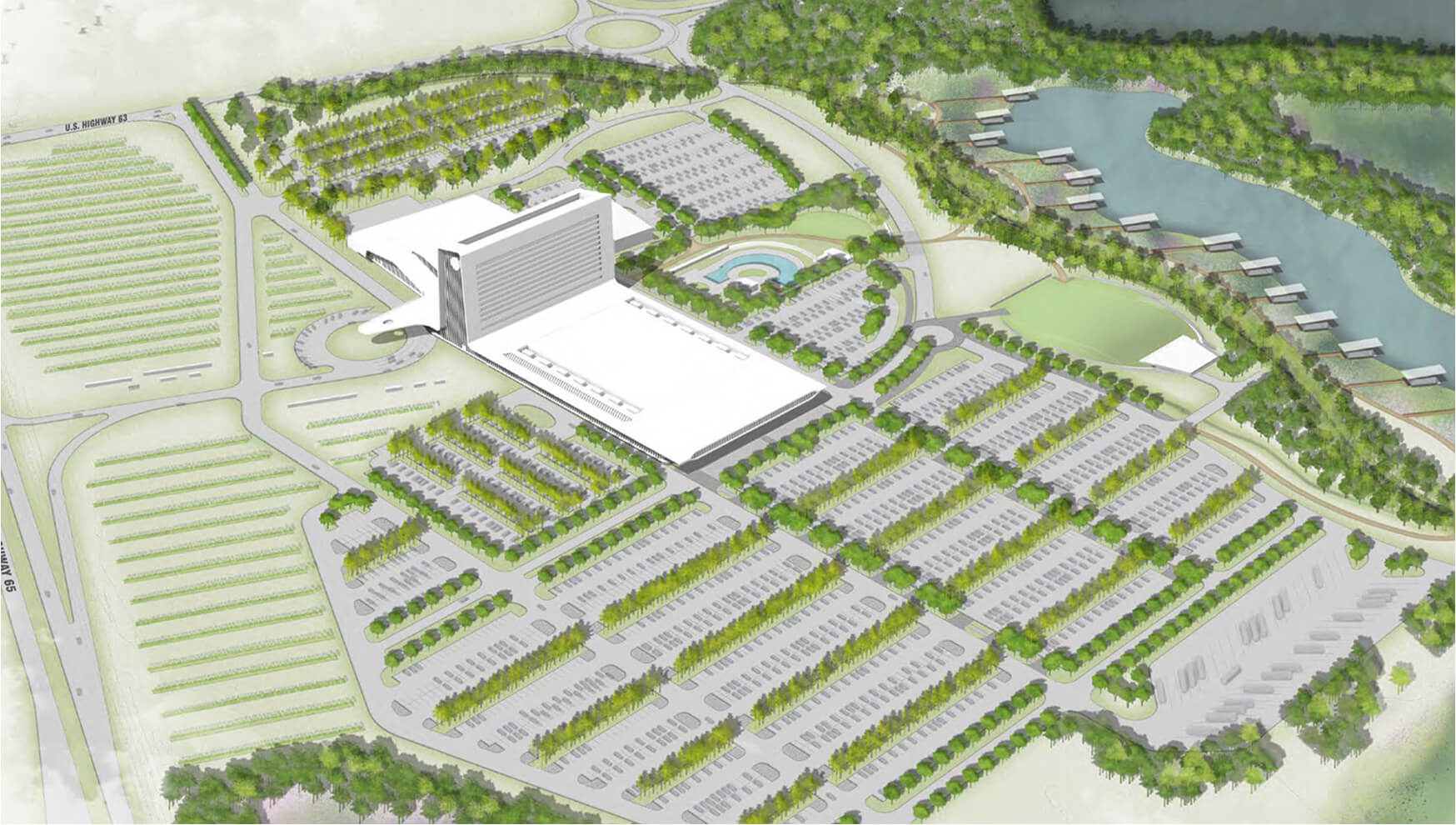An intellectual property (IP) dispute over the design of the Saracen Casino Resort in Pine Bluff, Arkansas, settled this past January, might easily have been a subplot in Netflix’s Ozark, as the case has all the twists and turns of a rustic neo-noir tale.
Saracen Casino is owned by the Quapaw Nation, based in northeast Oklahoma, with ancestral lands throughout Arkansas and neighboring states. Alleging he performed extensive design work from mid-2017 to March 2019 and then was abruptly dismissed, the Fayetteville, Arkansas–based design architect Marlon Blackwell Architects (MBA) sued the casino’s architect of record, Memphis, Tennessee–based HBG Design (previously Hnedak Bobo Group), for copyright infringement, attribution, tortious interference, breach of contract, and unjust enrichment. (Earlier developments in this case were covered by AN in 2019.) Other named defendants included John L. Berrey, tribal business committee chairman for two decades; his successor, Joseph T. Byrd; and Saracen Development, an Arkansas-registered LLC created by the Quapaw Nation for the project.
The case was settled out of court in January 2022, with undisclosed financial terms and an agreement that attributions for the building must be as follows: “HBG Design, Inc., architect of record, derived from an original design by Marlon Blackwell Architects, P.A.” The settlement bans the parties from discussing the case publicly beyond expressing satisfaction with its resolution. Mark Henry, MBA’s attorney, characterized the dispute as resulting at least in part from Berrey’s conduct, some of which came to light in mid-2020 after Byrd, who defeated Berrey in an election that July, had the nation’s financial records audited and found significant irregularities. Attorneys for HBG and the other defendants did not respond to requests for comment.

Blackwell v. HBG has substantial implications for the legal relations between design architects and architects of record. These partnerships occasionally fail, sometimes when design work proceeds based on informal agreements before the partners’ roles and scopes of work are formalized contractually. James R. Germano, manager and counsel at AIA Contract Documents (a separate organization from the national AIA, though headquartered in its Washington, D.C., base), said that “by using a coordinated set of construction documents … parties can clearly understand their roles and responsibilities, and thereby avoid disputes like this one.”
To architect Phillip Bernstein, who teaches professional practice at Yale University and was previously chair of the AIA National Contract Documents Committee, the case evinces both “traditional sloppiness around the management of intellectual property and someone who was willing to defend his intellectual property.” Among HBG’s defenses in a motion to dismiss was the assertion that there was no signed contract between the firms and thus no IP violation. This argument failed in court, as the judge held that MBA had alleged facts constituting a legally binding contract, including a responsibility matrix and an agreement specifying the fee split to hundredths of a percentage point. Still, the alleged arrangement constituted an “implicit contract,” although not a formal one explicitly defining IP rights.
Scenarios related to the removal of an initial architect from a project, Bernstein said, are a regular concern and can have several bad outcomes: “You don’t get paid, number one; number two, you don’t get any credit for your work; and number three, the associate architect takes your work and bastardizes it in some way. Copyright laws are all in place to prevent this sort of thing.” Bernstein added that he sees the case helping design architects everywhere. “Blackwell’s office did the profession a huge favor by demonstrating that you have rights, and you can protect your rights.”
Biting the hand that shared the .RVTs
According to MBA’s second amended complaint, part of a 99-document docket filed in U.S. district court, HBG pushed MBA out of the project. HBG then removed MBA’s logos, electronic metadata, and other “copyright management information” (CMI) from materials produced by MBA; passed off these designs as its own; and failed to pay MBA’s share of fees.
Blackwell, who originally met Berrey in 2015 through a mutual friend, designed the Quapaw Wellness Center (a.k.a., the John Berrey Fitness Center) in Quapaw, Oklahoma. Blackwell also designed the VIP entrance and lounge for the nation’s Downstream Casino and Resort in Quapaw. Arkansas Business News reported that Berrey asked Blackwell “to conceptualize a casino” in July 2017; Berrey used these initial designs in a campaign to get Issue 4, a constitutional amendment allowing casinos in four counties, including Jefferson (Pine Bluff’s county), onto Arkansas ballots in November 2018. The Quapaws’ Downstream Development Authority was the top donor supporting Issue 4, according to Ballotpedia. At that point, MBA claims it was the sole architecture firm working on Saracen Casino; its renderings, presented to the press and public in the late stages of the campaign, arguably helped sway voters. Issue 4 passed by a margin of 54 percent to 46 percent.

By 2019, MBA’s lawsuit alleges it had recommended HBG be engaged, despite Berrey’s initial objections, since HBG, which specializes in the hospitality and entertainment sectors, had worked on a competing casino in Hot Springs. The firm’s negotiated fees and the responsibility matrix were dated January 3, 2019, and MBA uploaded its Revit files onto HBG’s on-site and cloud-storage servers that month, with both firms able to access the materials.
On January 15, HBG and Berrey executed a letter of authorization stating that HBG would “coordinate with Marlon Blackwell Architects,” and HBG principal Paul Bell sent a fee-split memorandum, affirming that MBA would receive over $3 million, to Saracen Development agent Chris Roper on February 5.
That month, HBG’s lead designer, Mark Weaver, emailed Blackwell to request renderings that would be displayed at a National Indian Gaming Association conference, assuring him of proper attribution. On March 7, Berrey displayed MBA renderings at a meeting at the Pine Bluff Convention Center, as reported in the Northwest Arkansas Democrat-Gazette, and spoke of completing the casino by Valentine’s Day 2020.
By March 9, however, Berrey had apparently become agitated about MBA. Soon after, HBG personnel began locking MBA employees out of shared folders, and by the end of March the firm was deleting MBA’s CMI from its drawings. MBA’s complaint charged that HBG had “poisoned” the client’s view of MBA through unspecified misinformation.

MBA registered copyright for multiple Revit files from which HBG created derivative works. Incriminating items filed in the public record include direct evidence that HBG personnel manually traced over MBA’s documents; an internal HBG email dated April 10, 2019, in which Weaver, who had promised Blackwell credit two months earlier, told colleagues, “[L]et’s make sure Marlon’s team cannot see our new models until everything is resolved with them”; an admission by HBG’s Tom Wilkins on April 11 that folders had been renamed and MBA’s access removed; and an admission by HBG’s Rick Gardner on June 18 that he had “concern … that Marlon may file a complaint with the AIA that we are using his design without authorization.” Another message on April 23 from Memphis architect Kelly Shannon Kirk to Weaver and an unidentified recipient is more damning: “Dayum… rumors out of hbg doesn’t sound good. You took project from Marlon and kicked him to the curb.” (Hardball tactics also characterize HBG’s legal defense, which MBA says included a document dump of over 170,000 pages timed 22 minutes before the beginning of a key deposition in June 2021.)
Changes in tribal leadership recontextualized the unfolding story. Byrd investigated his predecessor’s handling of Quapaw finances, and, based on the findings, the nation filed criminal and civil suits in its own court system in April 2021, charging Berrey and others with multiple counts of embezzlement, abuse of office, conspiracy, and other violations of the Quapaw Criminal Code. During an October 2021 meeting, an auditor detailed some $34 million in misappropriated funds. Unauthorized perks, the nation claimed, included computers, tribal artwork, Rolex watches, spa visits, lavish meals and beverages, sports and concert tickets, and other items.
Berrey and seven co-defendants responded by filing slander and libel charges in an Oklahoma district court, which ultimately dismissed that suit on grounds of sovereign immunity (applicable in instances of disputes among the 6,000 tribes in the United States, each of which exercises independent power). Although the nation’s case against Berrey et al. is pending, its Business Committee disqualified him from running in the next tribal election, in part because his lawsuit in a non-tribal court strikes some as treasonous. If convicted in Quapaw court, Berrey would be sent to federal prison.
Black swan or representative case?
Leslie P. King, an architectural attorney with Carlton Fields in Hartford, Connecticut, who is admitted to practice in tribal courts in the state, reviewed the Blackwell case. She told AN that “what shocked me most is how blatantly obvious it seemed after reading the complaint…. Had the executive architect not just completely appropriated the design, in my opinion, they might have actually had a claim for something else.” To King, the alleged copyright infringement was egregious enough to take center stage over arguments about workload allocations, timetable, costs, or philosophical disagreement, among other topics. Berrey’s initial response to the suit, quoted in Arkansas Business, suggested another possible source of contention: “We think that Mr. Blackwell is a very talented boutique architect. But functionality and constructability was lost in our process.”
The case is “a very good reminder of architects’ duties,” King said, “especially when they take over someone else’s work, to be mindful of where is that line between my work and their work.” She added that the blatant violation makes Blackwell somewhat of a “black swan”: Her opinion was that had the case gone to trial, “a jury looking at those two pictures would have been all over [it]. I think a jury would have awarded pretty much anything that a judge would have permitted.”
Bernstein said that BIM usage weighs against any denial of appropriation by HBG; the firm’s position “does not speak well for their understanding of, or respect for, architectural intellectual property. The problem, of course, is that all the copyrightable material is highly liquid, because it’s all digital.” When “you’re working in someone’s Revit file,” he continued, “you’re essentially working in a three-dimensional, information-rich prototype proxy of the building. So the idea that you could have created a completely unique work of architecture when your starting point was somebody else’s Revit file is ridiculous.”
Germano noted that there are safeguards against this problem in AIA contract documents and said that these items are updated every ten years to reflect evolving technology, practice conditions, and case law; the next update related to BIM should arrive in 2023. Germano, who participated in the previous 2013 revision, also commented that documents B-111 and B-112—for agreements between owners and design architects and owners and architects of record, respectively—were updated earlier this year. These agreements are structured, he said, so that “the design architect owns all the intellectual property rights in the instruments of service that they create.” He also recommended the Lexis-Nexis case-finding tool AIA Legal Citator as a resource for architects, though it may be more familiar to construction litigators and contract negotiators. Perhaps its use could have saved HBG a few steps that strike expert observers as embarrassing.
After a COVID-delayed soft opening in October 2020, the Saracen Casino currently operates an 80,000-square-foot gaming area. However, the design’s most recognizable element, to accommodate a 13-story hotel, remains unbuilt, with no construction dates set at press time. The casino’s promotional website features exclusively indoor photography.
Bill Millard is a regular contributor to AN.
Editor’s Note: This article has been updated to clarify that it is reporting allegations made in a lawsuit filed by Marlon Blackwell Architects (MBA) against HBG Design, Saracen Development, LLC, and John Lane Berrey. The article should not be read to suggest that the court found the allegations in the lawsuit were true. The court never made a final ruling on the merits, and the case was settled before the close of discovery. Marlon Blackwell, MBA’s principal, previously served on The Architect’s Newspaper’s Southwest Editorial Advisory Board. Phillip Bernstein, a friend and former Yale colleague of Blackwell, wrote for AN during Blackwell’s tenure on the advisory board, which became inactive and was dissolved before this article was written. AN did not intend to accuse HBG of any wrongdoing.










